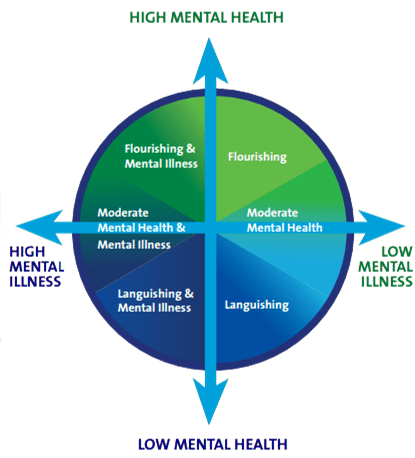A recent article by Adam Grant for the NYT described the experience of life during a pandemic as one where many of us are “languishing.” The piece reminded me of my love of Corey Keyes’ research on “flourishing” (the opposite of languishing, described as feeling pleasurable emotions and functioning well psychologically and socially) and has me thinking that reframing “mental health” may be more important than ever as we transition from pandemic life to whatever new normal will take its place.
Keyes’ research calls for a reimagining of how we conceptualize “mental health.” Keyes cautions that “the absence of mental illness is not the presence of mental health,” and proposes (based on large sample data) that it would be more accurate to separate mental illness and mental health into two separate constructs that can be overlaid on each other (see graphic below). The horizontal axis of this model represents the relative presence or absence of mental illness, whereas the vertical axis for mental health suggests functioning and experiences of life ranging from languishing (i.e. low levels of wellbeing) through moderate mental health to flourishing (i.e. high levels of wellbeing).
What I love about this “dual continuum model” is that the ability to flourish is NOT contingent on whether or not you have a mental illness. Instead, it proposes that flourishing is accessible for EVERYONE. Think of a person who, despite meeting diagnostic criteria for a mental illness, is able to feel good about themselves and their lives, and can function well more often than not. It is freeing to recognize that we can all do well and be well. When we access the resources we need (both internal and external), everyone can thrive.
On the other end of the spectrum, it is also important to recognize that everyone struggles at times. Languishing is marked by feelings of emptiness and stagnation. While these feelings may not be connected to a diagnosable condition that requires treatment, there are still significant impacts on our wellbeing when we are not living our life to the fullest or feeling our best.
Sadly, Keyes’ research showed that even prior to the pandemic, the majority of the sample that he studied were not flourishing, regardless of the presence or absence of any mental illness. We can only imagine how many more of us have struggled with experiences of languishing during the past year.
So what can we do for ourselves and each other to change our circumstances so that more of us can flourish, or thrive? A lot actually!
1) Try out some mindfulness. Paying attention to what is going on in the present moment allows us to notice things about ourselves and the world around us. It also anchors us in the here and now instead of ruminating on the past or worrying about the future, which are often sources of anxiety, dread, and other unpleasant emotions.
2) Find your flow. Another way to flex your “noticing” muscle is by paying attention to energy associated with your tasks. What fills you up and what drains you? Create a schedule or prioritize things to maximize your flow, engagement, and what you value most in life. Don’t forget about what your body is telling you! Notice what kinds of physical movement you look forward to or bring you the best energy boost.
3) Be intentional. Opportunities are present right now as we reconstruct and reopen our country and lives. Be empowered to create the life you want to be living. Changing the conditions in which we live, work, and play is a tenant of public health and it applies to our emotional health as well.
4) Connect with others. We’ve likely all learned by now the massive impact our social relationships can have on our wellbeing. Determining how you want to foster relationships and with whom can go a long way in our journey towards flourishing. Even connecting with strangers through random acts of kindness can give your wellbeing a boost!
5) Flex your brain power. Our minds are powerful and how we think of ourselves and our situations can directly influence our emotional state. Find opportunities to shift your mindset, reframe your thoughts, or otherwise flip the script towards gratitude, celebration, savoring, and growth.
If you’d like to try out some of these tools for flourishing, opportunities to do so have been integrated into the calendar of events for Flourishing at Dartmouth: A Week for Renewal & Growth kicking off on May 17! And if you want to read more on the topic, here’s a companion piece from the NYT to the Adam Grant article mentioned earlier, with even more strategies for flourishing.
Here’s to more flourishing in our futures!
Caitlin

